IJCRR - 5(7), April, 2013
Pages: 01-08
Date of Publication: 18-Apr-2013
Print Article
Download XML Download PDF
EVALUATION OF ORGANOLEPTIC PROPERTIES AND GLYCEMIC INDEX OF RECIPES WITH RICE BRAN
Author: S. Premakumari, R. Balasasirekha, K. Gomathi, S. Supriya, K. Alagusundram, R. Jagan Mohan
Category: General Sciences
Abstract:Rice bran is a simple item that delivers fantastic health benefits in our daily diet. This study delivers the importance of utilising all parts of the whole grain, including the bran. The objective was to develop the recipes incorporated with rice bran and evaluate their organoleptic properties and estimate their glycemic index. Ten standard Indian subcontinent recipes namely, chapati, mixed vegetable chapati, wheat dosa, wheat rava dosa, kozhukattai, ragi vermicelli, rice vermicelli and pulse based preparations namely adai, rava adai and ragi adai were chosen for incorporating rice bran at three levels, i.e. 25, 30 and 35 per cent replacing the cereals and pulses in the standard recipe. Ten healthy volunteers were selected for the study of glycemic index of each recipe. Comparing the 25 per cent incorporated rice bran with 30 and 35 per cent incorporation, 25 per cent was found to be most acceptable than the rest. The glycemic index of all the standard and the test recipes were compared statistically and the results showed that there is a significant difference in the test recipes when compared to the standard ones (p< 0.01). Recipes like wheat chapatti (52.40), mixed vegetable chapati (52.40), wheat dosa (52.81), wheat rava dosa (46.60), kolukattai (67.68), rice vermicelli (63.70) and ragi vermicelli (59.74) rice bran incorporated at 25 per cent level showed low and medium glycemic index compared to the standard recipes.
Keywords: Rice bran, organoleptic properties, recipes, diabetes, glycemic index
Full Text:
INTRODUCTION
International Diabetes Federation (IDF) states that two individuals develop diabetes every 10 seconds worldwide and two individuals die of diabetes related conditions every 10 seconds worldwide (IDF, 2007). The increasing trend of epidemiological transition is taking place in most of the States in India with decline in communicable diseases and increase in chronic non communicable diseases that has resulted in more than 50 per cent of total deaths in India (Thangappan, 2010). In recent years, consumers are dependent upon fast foods, which contain meager amount of dietary fibre. The American Diabetic Association (2007) recommends that individuals with diabetes mellitus increase the amount of dietary fiber in their diets in order to reduce blood glucose and insulin levels following meals. Liener et al., (2008) and Dunaif and Barbara (2008) reported that several dietary fibers can decrease the activity of human pancreatic amylase, lipase and trypsin. Trowell (2006) and Jenkins et al., (2006) and Miranda and Horwitz, (2007) assumed that addition of plant fibers to the diets of subjects with diabetes results in significant reduction in postprandial hyperglycemia.Qureshi et al., (2002) brought into limelight that soluble fiber such as rice bran plays an important role in decreasing cholesterol and controlling of blood glucose. Rice bran is obtained as a byproduct during the rice milling process and the outer layer or parts are removed at the time of polishing of husked rice (David et al., 2006). Stabilized rice bran (SRB), is a powerful source of vitamins, nutrients, proteins and fiber. The soluble and insoluble fibers are necessary for optimum digestion, blood sugar regulation, lowering cholesterol and prevention of diabetes and heart diseases. The stabilized rice bran contains an approximate insoluble versus soluble fiber ratio of 5 to 1. Rice bran exhibits a high digestive tolerance that occurs along the whole digestive tract with no excessive fermentation in the large intestine. SRB contains astounding quality of synbiotics, tocols, oryzanols, polyphenols, sitosterol and phytosterols. Rice bran is packed with full of omega 3 and omega 6 fatty acids ( oogenkamp, 2008). Healthy complex carbohydrates found in stabilized rice bran have “low glycemic index” which means they do not cause spikes in blood glucose (Sayre et al,. 2007). Every year, 63 to 76 million tons of rice bran is produced in the world and more than 90 per cent of rice bran is sold as animal feed for throw away price. Despite its excellent nutritional and nutraceutical properties, it is mainly utilized for animal feed. Earnest efforts are needed to incorporate this healthy ingredient back into our diet. Hence, the present study was undertaken to
- develop the recipes incorporated with rice bran and evaluate their organoleptic properties and
- estimate their glycemic index.
METHODOLOGY
Standardization of Rice Bran Incorporated Recipes
Ten standard Indian subcontinent recipes were chosen for incorporating rice bran at three levels, i.e. 25, 30 and 35 per cent replacing the cereals and pulses in the standard recipe. These included chapati, mixed vegetable chapati, wheat dosa, wheat rava dosa, kozhukattai, ragi vermicelli, rice vermicelli and pulse based preparations namely adai, rava adai and ragi adai. All the recipes selected were standardized in the laboratory.
Chapati is a form of roti made from wheat flour and water.
Mixed vegetable chapati is a roti made with wheat flour, water and mixed vegetables.
Wheat dosa is a fermented pan cake made from wheat flour.
Wheat rava dosa is a pan cake made from wheat rava and water.
Rice vermicelli is rice noodles made from rice.
Ragi vermicelli is ragi noodles made from ragi.
Kozhukattai is dumpings of rice flour using a mixture of grated coconut and jaggery as filling.
Adai is a thick pancake prepared from a batter of dhals namely urad, channa and moong dhal.
Rava adai is a thick pancake prepared from rava and seasonings.
Ragi adai is a thick pancake prepared from ragi flour and seasonings.
Conduct of Acceptability Trials
Each standard recipe was tried with incorporation of stabilized rice bran at 25, 30 and 35 per cent levels and tested by the 20 panel members in the age group of 20 to 25 years. The 5 point hedonic scale was selected for the evaluation ranging from extremely like to extremely dislike. The results of sensory evaluation indicated that 25 per cent of stabilized rice bran incorporated recipes were highly acceptable (Premakumari et al., 2012) (Table I) and glycemic index of these recipes were determined.
Determination of Glycemic Index of the Recipes
Glycemic Index is a measurement of how fast 50g of given carbohydrate raises blood glucose levels as it is digested while the glycemic index provides precise information about how 50g of the food will affect blood glucose levels (Anderson, 2007).
Ten healthy volunteers (adult men and women) of age 20 – 40 years were selected for the study of glycemic index of each recipe. Three days before the test period, all the subjects were asked to avoid consuming sweet preparations. On the first day of the experiment, fasting blood glucose was determined for all the subjects at 6 a.m. Then all the subjects were given 50 g of glucose in 250 ml of water to drink. The fasting blood glucose level was determined using glucometer using glucose strip which is based on the action of glucose oxidase and the value was recorded. Once in half an hour, blood glucose level was determined for all the subjects’ upto 2 hours. On the second day, all the subjects were fed with one of the 10 standard recipes and the quantities of the dish provided 50 g of carbohydrates which matched the glucose load of 50 g given on the previous day. On the third day, the subjects were made to consume the same recipes containing 50 g of carbohydrate incorporated with 25 per cent level of stabilized rice bran. The subjects were given 10 15 minutes for the consumption of the food. The subjects were not allowed to drink/eat any calorie containing foods. The blood glucose values for each subject were plotted against time in hours on a graph. The area under test recipe, standard recipe and glucose curves were determined. This procedure was repeated for all the ten standardized recipes and their Glycemic Index was determined. Glycemic Index was calculated using the following formula:
The Institutional Human Ethical Clearance number is HEC.2011.21 RESULTS AND DISCUSSION Organoleptic Evaluation The results of the organoleptic evaluation of 10 different rice bran incorporated recipes are given in Table II. Cereals and pulses are mostly used by Indians on daily basis. It is clear from Table II that the mean acceptability score of recipes in standard ranged from 8.35 to 8.8 and in recipes incorporated with 25, 30, 35 per cent of rice bran ranged from 8.05 to 8.45, 4.75 to 6.25 and 2.75 to 4.35 respectively. These scores were lower than the scores obtained by standard recipes. While comparing with the standard 25 per cent incorporation showed less difference than 30 and 35 per cent incorporation in all the recipes. Comparing the 25 per cent incorporated rice bran with 30 and 35 per cent incorporation 25 per cent was found to be most acceptable than the rest. Among the test recipes at 25 per cent level of incorporation of rice bran wheat rava dosa scored high (8.45) followed by rice vermicelli and kozhukattai (8.4), ragi vermicelli (8.2), mixed vegetable chapati (8.1) and chapati and wheat dosa (8.05). These findings showed that the lesser the addition of rice bran greater is the acceptability. According to Gajula et al., (2008) increase in bran level from 0 to 25 per cent significantly reduced the overall acceptability and all other attributes. Among the other preparations, 25 per cent incorporation showed greater acceptability out of all the test recipes when compared to the standard. Twenty five per cent level of incorporation of rice bran showed that ragi adai and rava adai had the acceptability value of 8.2 followed by adai with an acceptability value of 8.0.From the acceptability trials, it was concluded that the rice bran at 25 per cent level of incorporation is most acceptable compared to the other test recipes.
Glycemic Index of the Rice Bran Incorporated Recipes
Mean Blood Glucose Levels Glycemic index is a numerical system of measuring how much of a rise in circulating blood sugar that the carbohydrate triggers. Higher the number, the greater the blood sugar response.
Table III shows the mean blood glucose values of the selected subjects when fed with glucose, standard and experimental recipes with 25 per cent rice bran. When comparison was drawn between the standard and the test recipes, there was a significant difference in blood glucose values when compared at half an hour, one hour, one– and half hour and two hour intervals. Carbohydrates are known to account for the variations in the glycemic response to the meals, but GI also affected by factors such as the nature of starch, cooking and food processing methods and other dietary constituents like dietary fiber, fat and protein.
Glycemic index of the recipes The mean glycemic index of the standard and rice bran incorporated recipes is shown in the Table IV. The new glucose revolution refers the glycemic index as “the dietary solution for lifelong health”. The glycemic index of all the standard and the test recipes were compared statistically and the results showed that there is a significant difference in the test recipes when compared to the standard ones (p<0.01). Recipes like wheat chapatti (52.40), mixed vegetable chapati (52.40), wheat dosa (52.81), wheat rava dosa (46.60), kolukattai (67.68), rice vermicelli (63.70) and ragi vermicelli (59.74) rice bran incorporated at 25 per cent level showed low and medium glycemic index compared to the standard recipes. Diets based on carbohydrate foods that are more slowly digested, absorbed and metabolized (i.e., low glycemic index diets) have been associated with a reduced risk of type II diabetes and cardiovascular disease (Pankaj Modi , 2011).
CONCLUSION
Simplest things make the most significant difference in our lives. Bran is a simple item that delivers fantastic health benefits in our daily diet. This study delivers the importance of utilising all parts of the whole grain, including the bran. The low glycemic index response seen in bran incorporated recipes might increase the sugar levels for sustaining energy levels for longer periods of time thereby helping diabetics to feel less inclined towards food.
ACKNOWLEDGEMENT
The financial support received from ICAR National Agricultural Innovation Project is gratefully acknowledged. Authors also acknowledge the great help received from the scholars whose articles cited and included in references of this manuscript. The authors are also grateful to authors / editors / publishers of all those articles, journals and books from where the literature for this article has been reviewed and discussed. Authors are grateful to IJCRR editorial board members and IJCRR team of reviewers who have helped to bring quality to this manuscript.
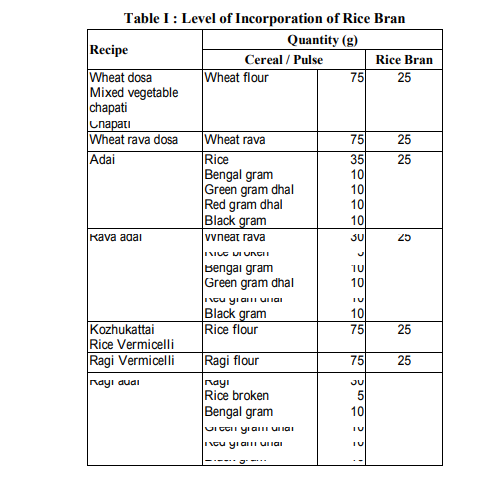
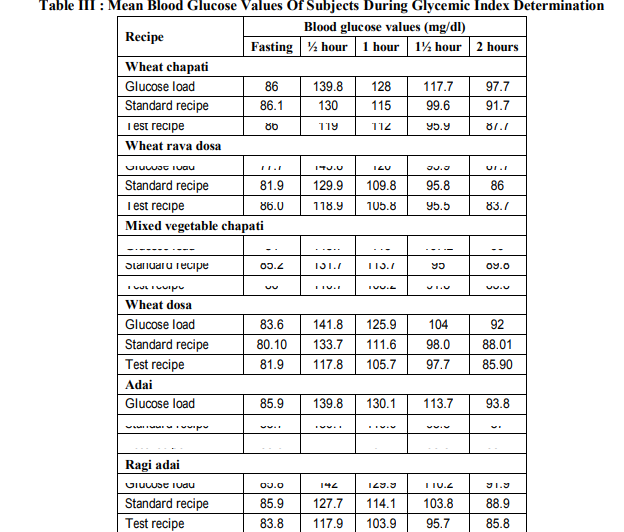
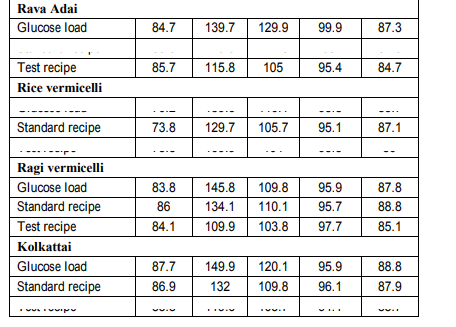
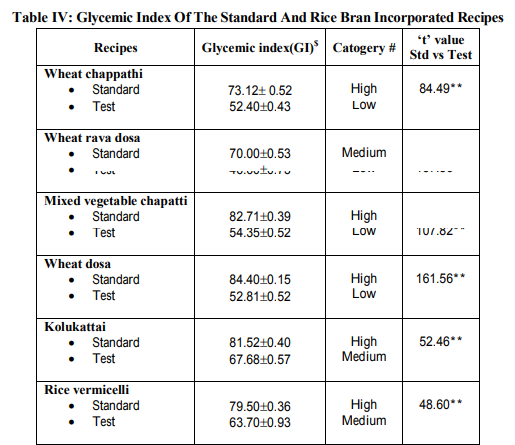
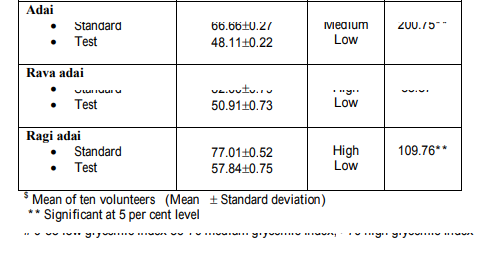
References:
1. International Diabetes Federation, (2007), “World Diabetes Media Kit: every 10 seconds 1 person dies of diabetes”, International Diabetes Federation, Brussels, Belgium.
2. Thangappan, (2010), “High Prevalance of Diabetes And Cardiovascular Risk Factors In India”, Diabetes Care, Vol.31. No3, Pp.1090 101
3. Puupponen pimia, (2002), Olson, BH., Anderson, SM., and Becker, MP., “Psyllium Enriched Cereals Lower Blood Total Cholesterol and LDL Cholesterol But Not HDL Cholesterol in Hypercholesterolemic Adults”, Results of a meta analysis. J Nutr, 127,1973–1980.
4. American Diabetes Association (2007): “Nutrition Recommendations and Interven tions for Diabetes”, Diabetes Care.,Vol. 30 (Suppl. 1):S48–S65.
5. Linear, Allgood, LD., Lawrence, A., (2008), “Cholesterol Lowering Effects of PsylliumIntake Adjunctive to Diet Therapy in Men And Women with Hypercholesterolemia”, American Journal of Clinical Nutrition, 71:472–479.
6. Dunaif and Barbara (2008), “Effects Of Concentrated Bran Fibre Preparation on HDL Cholesterol In Hypercholesterolemic Men”. Hum Nutr Clin Nutr 1984, 38C: 39–45.
7. Trowell, HC., (2006), “Diabetes Mellitus and Dietary Fiber of Starchy Foods”, Am J Clin Nutr, 31: 553–557.
8. Jenkins, DJA., Goff, DV., Leeds, AR., Alberti, KGM., Wlever, TMS., Gassull, MA., and Hockaday,TDR., (2006), “Unabsorbable Carbohydrates and Diabetes, Decreased Postprandial Hyperglycemia”, Lancet 2: Pp.172–174.
9. Miranda, PM., Horwitz, DL., (2007), “High Fiber Diets in the Treatment of Diabetes Mellitus”, Ann Internal Med 88: 482–487.
10. Mani, I., Patel, JJ., Mani, VV., (2008), “Studies on the Effect of Wheat Bran Fiber on Serum and Urinary Amino Acids and Amino Acids in Non insulin dependent Diabetic Patients”, J Clin Bio Chem Nutr 3: 143–148.
11. Qureshi, A., Sami. S. and Khan. F., (2002), “Effect of Stabilized Rice Bran, Its Soluble and Fiber Fractions on Blood Glucose Levels and Serum Lipid Parameters in Humans with Diabetes Mellitus Type I and II”, Journal of Nutritional Biochemistry,Vol.13. No.2, Pp. 145 87.
12. David, A.V., Dendy.D.A.V., Bogdan, J., and Dobraszczyk., (2006), “Cereals and Cereal products Chemistry and Technology”, Edition, I., Springer, Pp.312 313.
13. Bagdon, (2006), “Rice Bran Stabilization By Extrusion Cooking For Extraction Of Edible Oil”, Journal of Food Science, Vol.50, No.2, Pp.361 364.
14. Hoogenkamp, H., (2008), “Rice Bran Isolate: The Alternative For Soy Protein”, Poultry Processing Magazine, 4.2.2008. Pp20 22.
15. Sayre, R.N., Kahlon, T. S., Chow,I F.I., and Chiu.I.M.M., (2007), Diet, Life Style And Risk Of Coronary Heart Diseases, N.Engl.J.Med.,Vol.35, No.5, Pp.1991 2000.
16. Anderson, JW., Midgley, WR., and Wedman,B., (2007), “Fiber and Diabetes”, Diabetes Care 2: Pp369–379.
17. Gajula, H., Alavi, S., Adhikari, K., and Herald, T., (2008) “Pecooked Bran –Enriched Wheat Flour using Extrusion: Dietary Fiber Profile and Sensory Characteristics”, J Food Sci 73(4):5173–5179
18. Pankaj Modi, (2011) “Nutrition and Health, Nutrients, Dietary Supplements and Nutriceuticals”, Part 6, Pp.403 424
19. Premakumari,S., Balasasirekha,R., Gomathi,K., Supriya,S., Jagan Mohan, R., and Alagusundram,K., Development and acceptability of fibre enriched ready mixes, International Journal of Pure and Applied Sciences and Technology, 2012), vol. (2), pp.74 83
|






 This work is licensed under a Creative Commons Attribution-NonCommercial 4.0 International License
This work is licensed under a Creative Commons Attribution-NonCommercial 4.0 International License